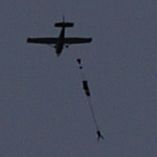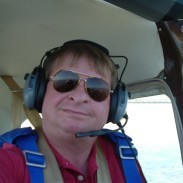Recommended Posts
mircan 0
QuoteYou also mentioned the AN-2 which I know well, and though I don't think they are legal anymore as the faa restricted them to airshows or something like that, they make a lousy jump plane.
Their size is perfect and have great short field performance, but once you get to 4,000 ft, you can either jump or take a long nap since thats where they stop climbing. Very inefficient for anything but hop & pops.
Here (see my country) AN-2s are OK for jump operations. They take forever to 10k feet, but if that is OK considering ticket price, no problem.
The problem is that you must have 10 people to get to altitude at all times or it is not economically viable. So it`s 2 tandems+2 videos and you need 4 more. Often, after 3 loads we don`t have enough people to fill in.
With Queen Air tandems and vidiots go in and you don`t need anybody else to fill in.
QuoteKnowing how to fly jumpers isn't important at take-off. On jumprun it helps, but you just need a guy with flight time, a twin rating, and some time in a Queen Air.
Than we are maybe ok.
QuoteThe airport makes a big difference. If you're jumping from a grass strip just barely long enough for the Queen Air, that's not good.
Than we are maybe not ok.
QuoteMaybe think about not putting in as many jumers as the plane will hold. Cut the load size by a slot or two, and that will help to build some additional safety margin.
Since we plan on putting 2 tandems+video than maybe we`re back to OK.
Even in a 182 full of jumpers that pukes its engine on takeoff, it requires an instantaneous push of the yoke forward to keep it from stalling. Though its hard to simulate a full load when checking them out, I get them up high and pull a few simulated things like that. It make a believer out of them and actually makes them safer. This is the way I was taught and I like to pass it on.
QuoteI think a main consideration when flying jumpers is that the pilot is prepared for an emergency at all times. Actually that goes for all flying anyway. But when briefing jump pilots who can get pretty bored and get real complacent with the job, I emphasize that emergencies come up instantly.
I agree 100%.
My comment was in regards to fact that their potential Queen Air pilot had little experience flying jumpers. While later on in the flight there are skills unique to flying jumpers, take off is no different than flying non-jumpers.
If this pilot was a good twin pilot with time in a Queen Air, than no having jump experience is no that big of a deal. Anyone who can safely fly a Queen Air can probably keep the thing upright during jumprun.
Likewise, a pilot with 1000 hours flying jumpers in a 182, and a fresh twin endorsement with 3 take offs and landings in a Queen Air would not be my first choice.
I was talking about the bonanza with the V tail
QuoteI was really interested why "death trap" attribute.
http://news.google.com/newspapers?nid=348&dat=19950911&id=YTAJAAAAIBAJ&sjid=9DYDAAAAIBAJ&pg=5075,2849170
Not the best report I'm sure, but it was the fastest one I could find in a quick search. This was in 1995 not all that long ago for parachute history.
Thought the newspaper account was wrong in that it said the plane was airborne for 10 minutes, it had actually just taken off and crashed shortly afterwards. The pilot had apparently feathered an engine. It was also reported that an engine was popping or mis-firing while on takeoff roll.
Fuel contamination was explained as a possible cause since they drew below ground fuel using a hand pump.
Failure to obtain/maintain minimum control speed was the FAA's conclusion.
Regardless of what made the engine/engines malfunction, it, like the Beech 18 accident in Hinkley Illinois should have been handled by the pilot.
Too many times pilots will try to keep the damn thing in the air. I won't go into too many details but there is a marking on the airspeed indicator which is called a blue line. If a pilot allows the plane to get to it or below that line and still cannot maintain a positive rate of clime, treat it like a single and put the damn thing down.
I don't have time to find the real report on the QA in West Pt. Or Hinkley, I'm sure both are on diverdriver.com.
I was making was related to the handling of the plane with an engine out.
Blue Skies
d123 1
I have like 50 jumps out of Navajo. It's a great plane. Is not your usual easy-to-lunch-4ways airplane like the twin otter or the caravan, you'll need to put a bit more attention in the exit but is great just because is not boring. There's a lot more wind speed at exit (100 knots) and this gives more control in the 1st sec (if you're ready for it ![]() ) Tracking jumps out of navajo are fun. We never had any problem with the horizontal stabilizer but we don't have so many wingsuits pilot there (they might be more affected).
) Tracking jumps out of navajo are fun. We never had any problem with the horizontal stabilizer but we don't have so many wingsuits pilot there (they might be more affected).
Inside is a very comfortable plane, climbs fast, descents not as fast as a twin or a caravan but fast enough to give 30 min back to back.
My DZ started with Cessnas, then they bought a Navajo, this year a 2nd one and the business bloomed a lot.
We also had an engine failure at 1500 feet which finished OK for everybody. IAD exit for students and bail out for regulars. Plane landed OK with 1 engine back to the LZ ![]()
mdrejhon 8
They might theoretically be able to treat it SkyVan-style. Red line across the floor/cieling. 4 people stay behind the red line. Launch the 6 way first. THEN the 4 people can safely scramble to jump out.QuoteIn other words you might be able to put 10 on the aircraft but you're not going to be able to launch more than a 6 way or the aircraft will tip over on jump run.
An extra safety margin can possibly be achieved by limiting the launch to 4-way, since the remaining 6 people will be shifting the center-of-gravity around getting ready to go for the door. I guess some experiments will be made someday, since this is the first time a Navajo, to the best of my knowledge, is running here for jump operations in Canada. (Correct me if I am wrong)
There will be a delay, but it won't be worse than the last 4 people out of a Twin Otter anyway, and it would be a great place to put more experienced jumpers (like me) to chase after a novice 4-way)
I jumped the Navajo last weekend for the creation of a YouTube video for a contest entry. I only had time to be at the dropzone for about 3 hours, but I got to go up two times! That's an impressive jump-frequency-per-time-at-dropzone only achieved at busy turbine dropzones or busy 3-Cessna dropzones. I do really like the Navajo despite its limitations. It's much more fun for us experienceds. We no longer have to wait, because they can cram in a 4-way team and couple of tandems, and two videographers. No more waiting for the tandem loads to go up before experienceds go up.
The air didn't feel bad at the door at all, I had more difficuty holding onto certain Twin Otters. That said, the door is fairly small, but I'll take a Navajo (especially at 12500) over a Cessna 182/205/206, especially if it means I now get to go up into the air almost three times as often in one day! (truly!)
For a Cessna dropzone, the Navajo is a major upgrade, and apparently, cost-effective. I hope that safety risk is worth it - there are worse flying deathtraps I've seen than this apparently lightly-used Navajo (I heard the dropzone was actually going to originally buy a NEW Navajo!)
P.S. Bonus points to those who find my YouTube video. It has me sitting in front of a parked Navajo, too -- if you want to see what a Navajo looks like. It also includes video of a ground climb-in, and video of me jumping out.
mdrejhon 8
That's reassuring I didn't jump from a death trap.QuoteWe also had an engine failure at 1500 feet which finished OK for everybody. IAD exit for students and bail out for regulars. Plane landed OK with 1 engine back to the LZ
Can you post a play-by-play of this failure, the local pilot probably would almost certainly appreciate getting in touch with your pilot. I am sure it is pilot training that helped, and I'd appreciate knowing that I helped two Navajo's pilot talk to each other about single-engine operation, can get you in touch with GO Skydive...
hackish 8
I'm more than happy with Roy's level of experience and abilities when it comes to flying the aircraft. Sometimes input from other sources can be combined to get a more full picture and this is why I've asked.
-Michael
mdrejhon 8
I can catch formations from 12500 feet wth a 7 second delay... In fact, I did one intentional 8-second delay for big way dive pratice (someone jumps out, we wait, then we jump out to chase to dock). I made it!
d123 1
I was not in the plane when it happen, my roomate was there and jumped out. The DZ is Parachutism Adrenaline from St-Jerome (a very nice place with great people) and the pilot can give you more information.
I've 1st jumped from Navajo at parachutism Victoriaville 2 years ago. I sugest contacting them too. A bunch of nice people ![]()
Hope it helps.
hackish 8
-Michael
Quote
We also had an engine failure at 1500 feet which finished OK for everybody. IAD exit for students and bail out for regulars. Plane landed OK with 1 engine back to the LZ
IADs at 1500'??!! Interesting choice.
mdrejhon 8
Another useful question... Left or right engine?QuoteWe also had an engine failure at 1500 feet which finished OK for everybody. IAD exit for students and bail out for regulars. Plane landed OK with 1 engine back to the LZ
There might be a difference in bailout success depending on which engine goes out, since exiting people may easily cause a stall in one case, and not in the other case?
Any comments from other pilots? (pilotdave, etc)








Knowing how to fly jumpers isn't important at take-off. On jumprun it helps, but you just need a guy with flight time, a twin rating, and some time in a Queen Air.
The airport makes a big difference. If you're jumping from a grass strip just barely long enough for the Queen Air, that's not good.
If you have a solid surface runway that's long enough, the pilot can just keep it on the ground long enough to build some extra speed before lift off.
Of course the field elevation, and the air temp also makes a difference.
Maybe think about not putting in as many jumers as the plane will hold. Cut the load size by a slot or two, and that will help to build some additional safety margin.
Share this post
Link to post
Share on other sites